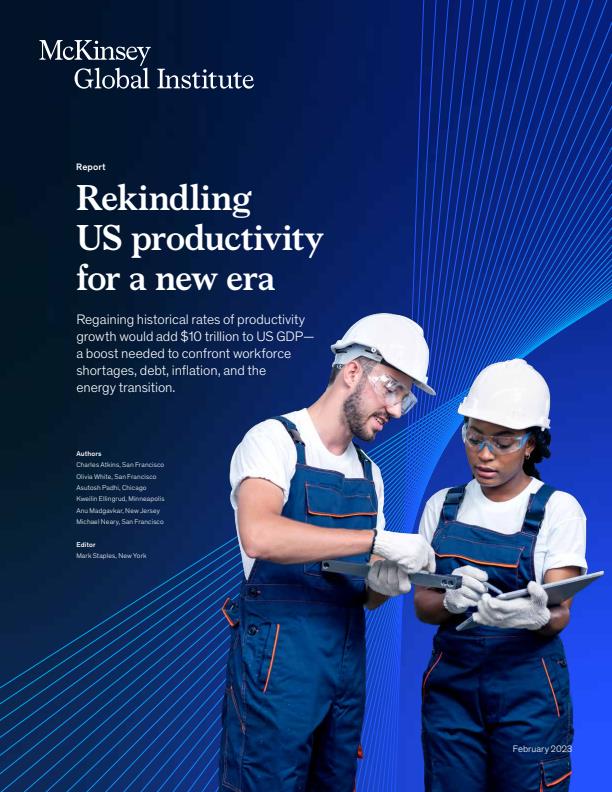At a glance
- Boosting US productivity represents a $10 trillion opportunity. That’s the potential cumulative increase in US GDP between now and 2030—equivalent to $15,000 per household—that could result from regaining the long-term productivity growth rate of 2.2 percent annually (exhibit).
- Looming challenges make productivity growth an imperative. Workforce shortages, debt, inflation, and the cost of the energy transition are powerful headwinds. All will be easier to confront with higher productivity.
- Since 2005, US labor productivity has grown at a lackluster 1.4 percent. At the same time, real wages have slowed and workforce participation has declined.
- Averages obscure important variation across states, cities, sectors, and firms. Some have become much more productive, while others are increasingly falling behind—and in many sectors the most productive firms are fivefold more productive (or more) than the least productive.
- Achieving and equalizing productivity gains will require concerted action. Priorities include unlocking the power of existing technology, investing in intangibles, improving workforce reskilling and labor mobility, and implementing place-based approaches tuned to specific geographies.

Introduction
Labor productivity growth1 has been the engine of US economic power and prosperity since World War II, adding 2.2 percent annually to economic growth and contributing mightily to a 1.7 percent annual gain in real incomes. Looking to the future, similar levels of productivity growth would help the country confront looming challenges, including workforce shortages, debt, inflation, and the cost of the energy transition. (For background on productivity, see sidebar “More with less: A productivity primer.”)
But if the US economy were a car, the engine has been sputtering for a while. In the past 15 years, productivity growth has averaged just 1.4 percent, even as incredible advances in digital technology put a supercomputer in every pocket. This state of affairs is well known. It is also not confined to the United States. Most OECD countries have seen a drop in labor productivity growth since 2005.2
In the US economy, there’s also a problem with the transmission. The link between productivity growth and real incomes has weakened. In the postwar boom from 1948–70, incomes grew at 3.0 percent annually,3 while productivity growth averaged 2.8 percent. More recently, real incomes have grown at 0.7 percent, well below the 1.4 percent gains in productivity (Exhibit 1). Worse, not everyone has shared equally in the relatively low gains in income, and labor participation rates have fallen from 67 percent in the 1990s to 63 percent in 2019,4 as millions have become discouraged about work.5

Returning US productivity to its long-term trend of 2.2 percent annual growth would add $10 trillion in cumulative GDP over the next ten years. This is equivalent to every US household seeing a cumulative income gain of $15,000 over that period. Other things being equal, it would also boost stagnating median incomes and encourage labor participation.6

WATCH
A McKinsey event on "Rekindling US productivity for a new era"
It’s an aspirational prospect and one with historical precedent. In 1995, five-year productivity growth averaged 1.6 percent, only for productivity to jump to 3 percent the following decade. Recent technology advances, including in AI and biotechnology as well as productivity spikes since the global COVID-19 pandemic, raised hopes (albeit briefly) that perhaps another boost may lie ahead.
It will not be easy, but some states, cities, sectors, and firms are growing productivity quickly and set an example. For example, from 2007–19, Washington and North Dakota raised productivity at a growth rate over 2.2 percent; California was close, at 2.1 percent. Seattle has powered growth in Washington, and San Jose and San Francisco have led the way for California. Among sectors, mining and information grew productivity faster than 2.2 percent, though together these represent only 10 percent of US output and 3 percent of working hours. Even in slower-growing sectors, such as manufacturing, the most productive firms outpace laggards by a factor of five or more.
The $10 trillion goal poses difficult but not insurmountable challenges. In this research, we review the patterns of productivity growth over the past 15 years, parse the challenges that lie ahead, and identify implications for business leaders and policy makers.
US productivity is a story of haves and have-nots
Averages obscure details that matter. Some states, sectors, firms, and cities have become significantly more productive—but those gains have been far from universal. These patterns of divergence highlight the unevenness with which the benefits of innovation, globalization, and other shapers of productivity have spread across the United States. (A similar story has unfolded in other nations; see sidebar “A global problem” for more.)
Inequality among states is on the rise
State-level productivity is diverging, with some states pulling away and others falling behind (Exhibit 2). This pattern is at odds with much of US history, when states converged in productivity and income levels.7
Seven states currently lead the way—California, Colorado, Massachusetts, New York, North Dakota, Texas, and Washington. These leading states are both more productive and increasing productivity faster than the US average. Together, they provide nearly one-third of the nation’s jobs and 40 percent of GDP.
In contrast, 25 states lag behind, with below-average productivity and slower-than-average growth; many are inland states east of the Mississippi. This lagging group is also large; it includes 44 percent of total employment and 37 percent of real GDP. In 2007, average productivity across these states was 83 percent of today’s leading states; by 2019 it had shrunk to 72 percent and by 2030 it will have fallen to 64 percent if productivity growth rates persist.
The remaining 18 states present mixed stories. Six states, representing 8 percent of employment and 9 percent of GDP, are slowing. They have above-average productivity—for now—but their average productivity growth was near zero for the past decade. The story is reversed for 12 growing states with below-average productivity but above-average productivity growth rate. Should these states maintain their growth, they will continue to converge with the US average level of productivity.
Surprisingly, sector mix within states explains little of the variation in productivity levels and none of the relative growth. High-productivity sectors have benefited some states, such as North Dakota, which benefited from the boom in natural gas, and California, which reaped the benefits of the technology boom. However, in aggregate, sector employment mix only explains a small share of the productivity gap across states.8 As an example, the eight most-productive sectors amount only to 28 percent of California employment—roughly the same share as in the United States overall.
Instead, both the absolute level of a state’s productivity and its growth rate seem to be driven by differences within sectors. For example, in 2007, information firms in California were 18 percent more productive than the US average, but this gap grew to 47 percent by 2017. In sectors such as retail, accommodation, and transportation, leading states have double or more the productivity of states that are lagging behind.
This means having a desirable sector mix is not enough—to secure productivity growth, states need to provide an environment that enables firms to thrive across all sectors. That growth is necessary for states (and cities) to fulfill their goal of delivering economic gains that are broadly shared.
Some sectors pulled ahead
Like states, sectors present a picture of productivity divergence (Exhibit 3). Sectors with the highest and fastest-growing productivity have often been powered by a combination of advances in digital technology and an advantageous place in global industries. In a 2015 study, we observed a 70 percent correlation between sectors’ productivity growth and their level of digitization over the previous 30 years (Exhibit 4). Unfortunately, despite—and perhaps because of—their relative productivity success, the sectors with the highest and fastest-growing productivity supply a disproportionately small number of jobs. They account for only 2 percent of new labor hours and on average generate 40 percent working hours per unit of output than other sectors.


Four sectors are leading, largely powered by adoption of digital technologies. Mining, information, finance and insurance, and wholesale trade all enjoy above-average productivity and have grown most rapidly since 2005. With the exception of mining, which has benefited from natural gas innovation, all are among the most digitized sectors in the US economy. Information, which includes businesses such as software, telecommunications, and internet publishing, has been a productivity superstar, averaging 5.5 percent growth since 2005, propelled by internet services and software. While these sectors represent 25 percent of the US economy, they only account for 15 percent of US working hours.
An additional four sectors representing 31 percent of the US economy are slowing: manufacturing, real estate, utilities, and management of companies have experienced slower growth but continue to outpace the US average. Employment in these sectors has shrunk, most notably in manufacturing, which dropped from 15 to 12 percent of national employment between 2005–19. Globalization has played an important role, shifting work in less productive subsectors such as textiles overseas, while highly productive, R&D-intensive subsectors grew rapidly. It also meant US firms shifted their place in global value chains, reducing their share in labor-intensive activities such as factory production while retaining high-value activities such as design. The result was that subsectors such as semiconductor manufacturing could shrink employment by 19 percent while expanding productivity by almost 50 percent.
In contrast, a group of services-led sectors (for example, accommodation and food services, healthcare) are badly lagging on productivity growth while also being among the least-productive industries. These sectors also provide a disproportionate number of jobs: while they contribute only 24 percent of economic output, they are responsible for 37 percent of hours worked. Worse, these sectors have accounted for more than two-thirds of employment growth since 2005, creating headwinds for overall productivity as more workers shift into less-productive work. These sectors tend to adopt technology more slowly than highly productive sectors do, attract lower-skilled workers, and operate more prominently in local value chains, with limited exposure to global markets.
A few growing sectors (retail trade, professional services, administration and waste management) have provided a relative bright spot; they are converging with the US average. Together they represent 31 percent of working hours and 21 percent of GDP. Technology accounts for part of their story: subsectors such as non-store retail (e-commerce) and computer and electronic products manufacturing have experienced robust growth.
In sum, technology adoption and competition have proved central to sector-level productivity improvement. Yet, the benefits of each have not been broadly shared to date.
Leading firms outpace the rest
The most productive firms in every sector have widened their lead on the rest. In fact, the gap between the most and least productive is wider within sectors than in any other dimension we studied. Manufacturing provides a particularly striking example; leading firms operate at 5.4 times the productivity of laggards.9 In some manufacturing subsectors, the differences are extraordinary. The leading semiconductor manufacturers are 38 times more productive than the least-productive companies. This mirrors other research showing similar patterns of divergence across other sectors such as wholesale trade and information.10
The “frontier firms” in the productivity vanguard are accelerating away from their peers. These firms tend to be larger, more connected to global value chains, and focus on technology-intensive aspects of their sector. Research suggests these leading firms invest 2.6 times more in technology and other intangibles such as research and intellectual property, and attract and invest in more skilled talent.11
As a result, the gap between frontier firms and laggards has grown over the past 30 years. In manufacturing, the gap was 25 percent wider in 2019 than it was in 1989, with most of that change happening before 2000. At the same time, industry dynamism has fallen, as seen in metrics such as new firm entry rate (which has declined 29 percent from 1989 to 2019 in the United States) and labor reallocation rates (which are down 31 percent across sectors).
Standard economic principles would suggest that less productive firms would be replaced or would improve their performance. Researchers have offered multiple hypotheses for why this has not happened. For example, there is evidence that firms within the same sector may coexist without fully competing, by serving different customers, attracting different workers, or operating in different geographic markets.12 Finally, some researchers have pointed to declining measures of competition as a source of the divergence,13 which remains a matter of active debate.
Whatever the explanation for growing divergence, productivity gains must ultimately come from firms. If laggards don’t catch up or get replaced by more productive firms, US productivity will continue to splutter. For business leaders, the message is clear: improving your firm’s performance matters much more than the productivity of the sectors in which you operate.
Cities emerge as engines of firm-level productivity
One link to these patterns across states, sectors, and firms appears to be city-level agglomeration effects (that is, the efficiencies from urban density), as a group of leading cities diverge from the rest (Exhibit 5). Within many of these cities are clusters of highly productive firms within related industries—think Silicon Valley technology companies or New York financial institutions. When firms set up shop near each other, they can benefit from pools of skilled talent, shared expertise, and local ecosystems of suppliers and customers.14 Urban inventors who are nearer to their competitors or peers produce more patents,15 and the flow of knowledge among different fields facilitates innovation based on atypical knowledge combinations.16
A handful of coastal cities such as Houston, San Francisco, San Jose, and Seattle have particularly benefited from these effects and jumped ahead of other areas of the United States. For example, Seattle was 16 percent more productive than other cities in 2007 but had become 38 percent more productive by 2019. These cities also account for much of the state-level performance—Seattle, for example, drove productivity growth at three times the rate of surrounding areas within Washington State while accounting for more than two-thirds of state GDP.
But being a city is no guarantee of growth; some cities have lost ground as they failed to spark agglomeration effects or find renewal as once-productive sectors shrank. Even among the 40 fastest-growing metropolitan areas, several historically vibrant cities (Chicago, Detroit, Orlando) have seen flat or negative productivity growth since 2005.
Increasing divergence among cities would matter less if talent moved freely across state and county lines. However, over the past 15 years, interstate mobility has fallen by a shocking 49 percent; county-to-county moves have fallen nearly as much (34 percent). Researchers point to many potential causes such as the growth in occupational licensing, policies that tie benefits to state residency, and high differentials in housing prices across regions.17 It remains uncertain whether pandemic-induced moves or increases in remote work might reverse this trend.
Cities are the engine of US productivity, bringing together ecosystems of firms and talent to create self-reinforcing agglomeration effects. Yet, productivity growth in cities is not predetermined; many cities that are now lagging were once the standouts of their era.
Looming challenges make productivity growth an imperative
Capturing the $10 trillion opportunity by returning US productivity to its long-term trend of 2.2 percent annual growth will require addressing existing challenges. Leaders will also need to confront the future’s changing context; indeed, a recent perspective from McKinsey Global Institute (MGI) suggests that we may be on the cusp of a new era. The most significant challenges today are insufficient skilled labor supply, uneven technology adoption, and stalling investment. All will remain relevant in the future as the workforce ages and the frontiers of technological possibility expand while interest rates rise. At the same time, shifting geopolitical dynamics and the net-zero transition introduce new complications that make productivity growth more needed than ever.
Workforce shortages will remain a challenge
Insufficient labor supply is among the most acute challenges facing firms today. Skilled-worker shortages remain a significant constraint on productivity growth across the spectrum of sectors and firms, especially as technology investment grows. In October 2022, there were 10.3 million job openings according to the Census Bureau, but many business leaders complain of not being able to find qualified workers. At the same time, labor force participation rates have fallen to 62 percent from a high of 67 percent in the late 1990s, as workers are unable or unwilling to find work that matches their skills.
Historically, access to skilled talent has long been a prerequisite of productivity growth; the past 30 years have seen soaring returns to human capital for firms that invested in people.18 Those that freed their top thinkers, engineers, and creatives to work on their toughest problems, and supported them with technology and other intangibles, experienced outsize returns. Meanwhile, workers lacking the skills the modern economy demands have been less fortunate, with many discouraged from the labor force altogether, driving down labor participation.
Since the pandemic, three groups in particular have opted out of the labor force: aging baby boomers, women with children,19 and men without college degrees. An additional source of human capital has lately slowed. In the early years of this century, immigration bolstered the perpetual quest for skilled labor. Immigrant numbers grew by 4.6 percent from 1990 to 2000. But growth slowed to 2.5 percent from 2000–10 and just 1.1 percent from 2010–21. Another source is also under threat. As skilled boomers retire, they will take important institutional or technical knowledge with them.
Reskilling workers to make up for the shortfalls and meet evolving job demands will be a massive undertaking. To take a single sector as an example, MGI estimates 550,000 new energy transition jobs will be available by 2030.20 Who will fill them?
Getting this right will not only unlock greater productivity growth but also address a second looming challenge for the US economy: raising the labor force participation rate by bringing discouraged workers back into the labor force.
Technology is advancing but even now its benefits aren’t broadly shared
Technology has lifted productivity for some sectors and firms, yet its benefits have not been fully captured nor broadly shared.21 In a recent survey, companies report that digital transformations fail five times more often than they succeed.22 A colossal opportunity awaits if the country can collect the benefits of today’s technologies (never mind what’s to come) and ensure that its dividends are spread economy-wide.
That “what’s to come” bit is even more tantalizing. New so-called transversal technologies such as artificial intelligence and bioengineering are advancing by leaps and bounds. To unlock value from truly new technology, firms must reconfigure how they work, often over sustained periods, as they tinker with processes and workers adapt their skills. This is not a new phenomenon: historically, revolutionary general-purpose technologies such as electricity took multiple decades before the productivity benefits were clear.23 Investments in technology require complementary investment in intangibles such as talent, ecosystems, and organizational models. As researchers such as Erik Brynjolfsson24 have highlighted, over time this process creates a productivity “J-curve” in which initial benefits may only be small (or even negative) but long-term value is substantial for firms that sustain the journey.
Firms’ readiness for these new technologies may be improving. The COVID-19 pandemic sped up investment in AI and automation as firms responded to the needs of remote work.25 But productivity measures since the pandemic have been mixed.
To be ready to capture value from digitization today and the new technologies of tomorrow, firms will need to build their capabilities with the right investments in skilled talent, operating practices, and platforms.26
Investment has lagged, and macro uncertainty could dampen it further
Investment supports labor productivity by adding tangible capital (such as land or equipment) and intangible capital (such as R&D, software, human capital, and brands). Since 2005, investment of all kinds slowed despite record low interest rates, even as firm profitability and foreign investment grew. Investment has grown since then but has yet to return to pre-2005 levels. Understanding the factors constraining investment is important since too little investment may dampen long-term productivity growth.
Complicating matters, firms today are confronting a new capital markets reality. Interest rates are higher, as is asset price volatility.27 More turbulence may be ahead as global balance sheets deleverage. How this will impact investment is unclear: in the long term, real interest rates matter and they remain low. But volatility can have a dampening effect on its own and is likely to have the most effect on long-term investments.
Firms have certainly noticed that intangible investment (in R&D, software, and so on) has boosted performance.28 Yet growth in these investments has been sluggish. This suggests that many firms may have set their hurdle rate too high. There are several possible reasons: many intangible investments may not have yielded a return, intangibles may be perceived as riskier given they are difficult to collateralize and have limited recovery value, or firms may simply be taking a short-term perspective and are unwilling to invest through the J-curve associated with intangibles investment. Boosting productivity growth will require addressing this hesitancy to invest, even amid choppy macroeconomic waters.
The energy transition introduces trade-offs between speed and affordability
Over the past 30 years, energy costs have remained relatively stable even as economic output more than doubled. US energy producers responded to market signals through innovations such as fracking. At the same time, businesses and consumers also adapted by increasing energy efficiency. While greenhouse-gas (GHG) emissions did not go down, they did remain stable.
As firms now embark on the transition to net-zero emissions, the rising cost of energy could turn into a headwind for productivity. Business leaders and policy makers will need to manage trade-offs between the speed of transition and affordability. MGI estimates that for the United States to reach net zero, investors will need to pump in an additional $1.7 trillion annually until 2050, much of which is not currently planned.29 Freeing up those resources will require higher productivity growth. In the short term, with energy markets in turmoil, investments in net zero could dampen productivity growth, thereby also making subsequent investments needed for the transition less affordable. But the road to net zero will also present some new opportunities to bolster productivity—for example, through decreased volatility of energy costs—and for job creation—such as through new manufacturing or construction jobs.30
Reimagined globalization can better account for all people and places across the United States
Globalization has been a powerful force for productivity growth for more than 30 years, especially in the 1990s and early 2000s, but also including the past 15 years. Globalization drives firm productivity through exposure to overseas competition, access to ideas, and specialization. Global value chains sprung up, and leading firms staked out a global presence.31
However, the productivity benefits of globalization were not uniform, with some states, sectors, firms, and workers left behind. Sectors insulated from global forces (for example, healthcare) have seen fewer benefits, while others—such as textiles, exposed to global competition but unable to respond—have withered. And workers in many parts of the United States were not able to transition to new jobs as their old ones moved overseas, fueling some of the observed geographic disparity.32
In the new era taking shape now, trade policy and other economic institutions are likely to be revisited as the world becomes more multipolar and as noneconomic strategic options are considered. Policies that preserve the benefits of global interconnectedness while fostering resilience and better distributing the gains of globalization could enhance productivity, as workers and value chains adjust and build greater resilience to global shocks.
Achieving and equalizing productivity gains will require concerted action
Our findings suggest that grasping the $10 trillion productivity opportunity requires concerted effort by business leaders and policy makers in five areas (see sidebar “A productivity agenda for CEOs” for a checklist of the biggest ideas for business).
Build an American workforce for the future
Addressing the labor participation rate, the workforce shortage, and skills gaps will take a sustained step change in government and business initiatives and will likely involve multiple levers to build skills throughout American workers’ careers and forge a new talent pipeline.
Leaders can start by increasing the supply of newly trained workers. Improved access to education through community colleges, apprenticeships, and vocational programs, as well as reforming the visa process for skilled foreign workers, would provide a welcome boost. Private- and public-sector talent reskilling programs must be scaled up to help more people acquire the skills they will likely need in the future and match them with prospective employers. Skills acquired on the job explain a large proportion of workers’ earnings and can be purposefully developed through on-the-job experience, training, and mobility.33
Labor market frictions that inhibit matching of talent demand and supply will also need to be addressed. Companies could support hybrid and remote work where it makes sense. Policy makers could reduce burdensome noncompete rules and occupational licensing programs. The high cost of housing in many cities deters job seekers and may prevent cities with already strong agglomeration effects from reaching their full potential. Rethinking hiring approaches by moving from credential-based hiring toward skills-based models would open up new pools of talent and recognize the value of experience in the workforce.
Finally, specific efforts will be needed to retain those leaving the workforce in disproportionate numbers, such as women and retirement-age workers. Policies that improve access to affordable childcare and make it easier to take parental leave would help parents (especially women) remain in the workforce. Greater flexibility on the career path would make it more attractive for retirement-age workers to stay in the workforce.
Bend the curve of technology adoption
Firms can take action to realize the promise of already established digital technology and prepare themselves to gain from nascent or yet-to-be-developed innovations. Those whose productivity is not where it could be can emulate leading firms, which do a few things consistently well. They commit to their digital strategy and devote sufficient resources to it as a core organizational priority. They mobilize the entire organization around their transformation, sharing responsibility and ownership of the transformation. They are flexible and agile, focusing on continuous development and making bold bets to reinvent themselves. And they invest in the right technology-ready talent to help execute these bets at both the frontline and managerial level.34
Encourage investment in intangibles
Policy makers can support the intangibles economy by setting the right environment for intangibles to flourish. Reforms to intellectual property rules and competition policy can ensure that incentives for innovation persist while addressing contexts in which overly expansive protections or industry dynamics are stifling competition. Such changes will need to be finely tuned by sector and even firm, recognizing the role of global value chains and natural returns to scale in helping large, productive, intangibles-based businesses grow.
Government can also directly support innovation by coordinating across value chains, clarifying regulatory standards, and streamlining policy to ease constraints on new investments. Agencies such as NASA have done this successfully in the past, giving rise to new ecosystems of high-tech manufacturing. Policies that ease land-use regulations could do the same for areas such as renewables by making it easier to build solar, wind, and geothermal generation facilities and the electrification infrastructure they require. Recently passed federal legislation (the CHIPS Act,35 Bipartisan Infrastructure Law36) may help, containing potentially promising avenues to increase research and development.
Balance energy affordability and productivity
In confronting the net-zero transition, business leaders and policy makers will need to manage the trade-offs between affordability and the speed of transition. Policy makers and other stakeholders can fine-tune their strategies to recognize the different costs and length of transition in each sector and each region. Three categories of actions stand out. The first is moves to catalyze effective capital allocation and new capital structures to scale up new innovations, align incentives, and manage risk for existing assets. A second set of actions seeks to manage demand shifts and support innovation with R&D investment and nurturing new ecosystems. And a final group of actions would consider the way that consequences of the transition are distributed by reskilling affected workers and economic-diversification programs for affected areas.
Address people and places left behind
Among the most confounding patterns of US productivity growth is the relative stagnation of specific geographies that suffer the twin problems of low productivity growth and low labor force participation. This includes cities that have failed to spark productivity growth as well as rural areas falling behind. As Anne Case and Angus Deaton have documented, these economic outcomes are often accompanied by social ills such as lower life expectancy and higher rates of substance abuse.37 And in many cases, workers are unwilling or unable to move, given factors related to skills levels, cultural affinity, and benefits tied to state residency.38 Skilled talent is increasingly concentrated in select cities, leading to their relative outperformance, but also heightening the challenge for those looking to recruit such talent.39
Place-based policies attempt to address these “left behind” areas but have a checkered history, with evidence of both success stories (for instance, the Tennessee Valley Authority) and failures. Academic reviews of such policies have generally failed to see self-sustaining benefits.40 Yet, people-based policies such as the earned income tax credit have not been sufficient to address the scale of the problem. Place-based policies should be explored further to identify specific interventions that work and where such interventions are best targeted.
Returning labor productivity growth to its historical level is among the most important challenges facing the US economy. Success will deliver not only greater prosperity, but also help finance the net-zero transition, bring workers back to the job even as the population ages, and put the brakes on rising inequality. Fortunately, the wellspring of American innovation remains strong even if unevenly distributed. By taking action on several fronts, business leaders and policy makers can accelerate productivity and create a more sustainable and inclusive economy in the new era.



